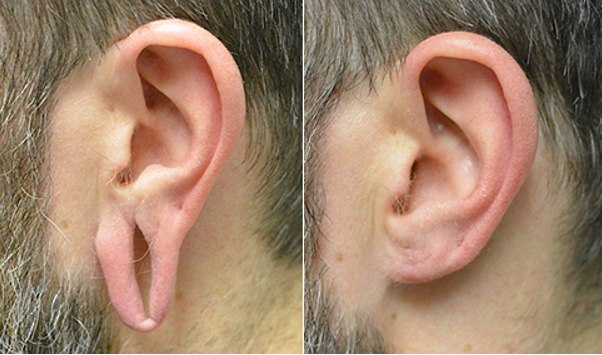Stretched earlobes can be a source of embarrassment. Just like other areas on the face, earlobes tend to lose volume and elasticity over time, leading to elongation, sagging, creases and an overall jaded appearance. However, earlobe repair can improve these issues. Ear lobe repair or rejuvenation is usually a quick, painless and very rewarding procedure. With earlobe repair you can hide one of the telltale signs of trauma or aging. It also has a functional value as it allows your earrings to sit properly in your earlobe, rather than drooping off your ears. An earlobe repair can reverse the look of stretched ear piercing which may be a blotch on your otherwise beautiful face.

There are many reasons for earlobe repair – it could be because of a split earlobe or widened ear piercing holes or something else. Ear lobe rejuvenation is the latest trend in facial plastic surgery and it requires expertise and precision. Split earlobes are often caused by trauma such as an accident, in which the earrings are pulled through the piercing hole. For example, a baby jerks a dangling earring out of his/her mom’s ear. The result is a defect that runs from the piercing point to the end of the earlobe. The tear can be incomplete as well, resulting in an enlarged hole. Apart from that, wearing heavy earrings can lengthen the piercing hole and eventually pull through over time. It is a condition that is generally seen among people with thin earlobes.
Ironically, split earlobes can even occur in people who don’t have their ears pierced. At times, clip-on earrings that are too tight can restrict blood flow to the earlobe, leading to necrosis or death of part of the earlobe, resulting a split earlobe. However, some people may have split earlobe by birth. Rarely, the piercing hole is purposefully stretched in order to accommodate a large gauge ear tunnel. The good news is it is something that can be reversed completely. In this article, let us go through what it takes to fix a split, partially split earlobe or a stretched piercing hole.
In order to correct a split earlobe, a widened piercing hole or an elongated ear piercing, a surgical procedure is necessary. First, the area will be cleaned with an antiseptic. In order to numb the area, a local anesthetic is injected into or around the area that is to be fixed. A small amount of skin surrounding the split or widened hole is cut out and then re-stitched back together. Depending on the type of the suture material (absorbable and non-absorbable), you may have to return for suture removal. In case of absorbable suture material, it is absorbed by the body and no need to be removed in about five to seven days. Fillers can also be used to add volume to a deflated earlobe and to correct earlobe.
Post procedure, you will be observed for some time and if there are no complications, you will be able to go home following the repair. If you are considering having an earlobe repair, it is very important to choose the right surgeon. Let your surgeon know if you have large scars or keloids and make sure your talk about how you want your earlobe to look like. Some surgical techniques involve leaving a small tract or hole for earrings after the repair. Inform the surgeon in advance if you want to wear earrings post surgery, it will enable the surgeon to choose the proper technique for you.
If you notice mild bruising and swelling post surgery, needn’t worry, that is normal after the surgery and it will go away in a week or two. There may be a mild scar at the site of the repair, if you don’t have a history of scar formation, it will also fade away with passage of time. Your ears can be safely pierced again in about six to eight weeks.
Post-surgical care:
Your surgeon will inspect the wound in a follow-up visit. Usually, wound should be kept dry for the first 24 to 48 hours post surgery. After that time period, daily wound care may be recommended. Patients may shower and wash their face the following day (but keep the wound dry). Your doctor may prescribe an ointment to be applied to the area of the surgery. In the unlikely event, if you have the history of scar or keloid formation, your doctor might prescribe silicone gel sheeting or injections. Mild exercises can also be done the following day. It is good to avoid sleeping on a flat surface following surgery. Keep the head slightly elevated during sleep at the first night following surgery to minimize swelling.
Will I experience much pain?
No. The surgery is performed under local anesthesia. People generally do very well after treatment and pain is minimal. Discomfort is controlled nicely with painkillers post repair. The application of ice the evening after surgery helps to minimize swelling..
The goal of earlobe repair is to create earlobes that have a more normal shape and size, which are in harmony with the rest of your facial features.
For Enquiries and Online Appointments
For more detailed information about Earlobe Repair, please send us a message today.

